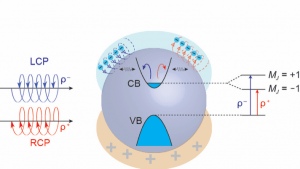Summary
Thanks to the light-induced collective oscillations of free charges at the boundary between a conducting material and a dielectric, known as surface plasmon resonance, metallic nanostructures can exhibit strong light absorption and scattering. The sensitivity of these resonances to the local environment and shape of the metallic structures allows them to be used, for example, in chemical sensing and cancer therapy. Semiconductor and metal-oxide nanoparticles expand possible wavelengths of surface plasmon resonances into the infrared spectrum and can possibly allow for coupling of the surface plasmon resonances of the nanoparticle, which are of classical nature, to the particle’s semiconductor band structure, which arises from quantum states of the charge carriers. These charge carriers are the electron-hole pairs known as excitons in the semiconductor.
We have recently developed a new method to produce doped transparent-metal-oxide plasmonic nanocrystals and used these to demonstrate for the first time a plasmon-exciton coupling in any plasmonic semiconductor system. Our goal in this project is to further explore the plasmon-exciton coupling in semiconductor and metal-oxide nanostructures and to develop methods to use this coupling for plasmon control of the quantum states of single defects and for their entanglement. We expect this will open the door for these systems to be deployed in quantum sensing and computing applications. In particular, we believe our studies will lead to the design of inexpensive and highly sensitive magneto-optical sensors for thermal imaging and molecular sensing.

Related Content

Quantum Simulation of Strongly Coupled Field Theories
Strongly-coupled field theories describe both fundamental and applied quantum problems.
August 10, 2017

On-Chip Microwave-Optical Quantum Interface
Summary In this project we develop a quantum interface between microwave and optical photons as a key enabling technology of a hybrid quantum network. In such a network, the robust optical photons carry quantum information through optical fibres over long distances, while superconducting microwave circuits protected from thermal photon noise by the low temperature […]
October 29, 2018

Applications of Neutron Interferometry and Structured Neutron Beams
Summary Neutrons are a powerful probe of matter and physics due to their Angstrom size wavelengths, electric neutrality and relatively large mass. In this project, we develop quantum sensors that exploit these attributes to increases the precision of measurements of fundamental forces and materials structure. With David Cory, Alexander Cronin of the University of Arizona, […]
July 31, 2018

Carbon Nanotube Monolayer Josephson Junction Superconducting Qubit
Carbon nanotubes (CNTs) are a promising material for use in Josephson-Junctions (JJs) given their unique properties, such as high electrical conductivity, pristine surface, inherent nanoscale dimension, and silicon-compatible processing
June 1, 2017

